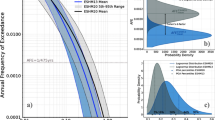Abstract
Romania has one of the highest seismic hazard levels in Europe. The seismic hazard is due to a combination of local crustal seismic sources, situated mainly in the western part of the country and the Vrancea intermediate-depth seismic source, which can be found at the bend of the Carpathian Mountains. Recent seismic hazard studies have shown that there are consistent differences between the slopes of the seismic hazard curves for sites situated in the fore-arc and back-arc of the Carpathian Mountains. Consequently, in this study we extend this finding to the evaluation of the probability of collapse of buildings and finally to the development of uniform risk-targeted maps. The main advantage of uniform risk approach is that the target probability of collapse will be uniform throughout the country. Finally, the results obtained are discussed in the light of a recent study with the same focus performed at European level using the hazard data from SHARE project. The analyses performed in this study have pointed out to a dominant influence of the quantile of peak ground acceleration used for anchoring the fragility function. This parameter basically alters the shape of the risk-targeted maps shifting the areas which have higher collapse probabilities from eastern Romania to western Romania, as its exceedance probability increases. Consequently, a uniform procedure for deriving risk-targeted maps appears as more than necessary.











Similar content being viewed by others
References
Douglas J, Ulrich T, Negulescu C (2013) Risk-targeted seismic design maps for mainland France. Nat Hazards 65(3):1999–2013. https://doi.org/10.1007/s11069-012-0460-6
EN 1990:2002 + A1 (2010) Eurocode - Basis of structural design. European Committee for Standardization, Brussels, Belgium
EN 1998-1 (2004) Design of structures for earthquake resistance—part 1: general rules, seismic actions and rules for buildings. European Committee for Standardization, Brussels, Belgium
Fajfar P, Dolšek M (2012) A practice-oriented estimation of the failure probability of building structures. Earthq Eng Struct Dyn 41(3):531–547. https://doi.org/10.1002/eqe.1143
Goulet CA, Haselton CB, Mitrani-Reiser J, Beck JL, Deierlein GG, Porter KA, Stewart JP (2007) Evaluation of the seismic performance of a code-conforming reinforced-concrete frame building—from seismic hazard to collapse safety and economic losses. Earthq Eng Struct Dyn 36(13):1973–1997. https://doi.org/10.1002/eqe.694
Kennedy RP (2011) Performance-goal based (risk informed) approach for establishing the SSE site specific response spectrum for future nuclear power plants. Nucl Eng Des 241(3):648–656. https://doi.org/10.1016/j.nucengdes.2010.08.001
Lin PS, Lee CT (2008) Ground-motion attenuation relationships for subduction-zone earthquakes in Northeastern Taiwan. Bull Seismol Soc Am 98(1):220–240. https://doi.org/10.1785/0120060002
Luco N, Ellingwood B, Hamburger RO, Hopper JD, Kimball JK, Kircher CA (2007) Risk-targeted versus currents seismic design maps for the conterminous United States. Proceedings of the 2007 Structural Engineers Association of California (SEAOC) Convention, Lake Tahoe, CA
P100-1/2013 (2014) Code for seismic design—part I—design prescriptions for buildings. Ministry of Regional Development and Public Administration, Bucharest, Romania
Pavel F, Vacareanu R, Douglas J, Radulian M, Cioflan C, Barbat A (2016) An updated probabilistic seismic hazard assessment for Romania and comparison with the approach and outcomes of the SHARE project. Pure Appl Geophys 173(6):1881–1905. https://doi.org/10.1007/s00024-015-1223-6
Silva V, Crowley H, Bazzurro P (2016) Exploring risk-targeted hazard maps for Europe. Earthquake Spectra 32(2):1165–1186. https://doi.org/10.1193/112514EQS198M
Ulrich T, Negulescu C, Douglas J (2014) Fragility curves for risk-targeted seismic design maps. Bull Earthq Eng 12(4):1479–1491. https://doi.org/10.1007/s10518-013-9572-y
Vacareanu R, Pavel F, Aldea A (2013) On the selection of GMPEs for Vrancea subcrustal seismic source. Bull Earthq Eng 11(6):1867–1884. https://doi.org/10.1007/s10518-013-9515-7
Vanzi I, Marano GC, Monti G, Nuti C (2015) A synthetic formulation for the Italian seismic hazard and code implications for the seismic risk. Soil Dyn Earthq Eng 77:111–122
Wald DJ, Allen TI (2007) Topographic slope as a proxy for seismic site conditions and amplification. Bull Seismol Soc Am 97(5):1379–1395. https://doi.org/10.1785/0120060267
Woessner J, Danciu L, Giardini D, Crowley H, Cotton F, Grünthal G, Valensise G, Arvidsson R, Basili R, Demircioglu MB, Hiemer S, Meletti C, RMW M, Rovida AN, Sesetyan K, Stucchi M, the SHARE Consortium (2015) The 2013 European Seismic Hazard Model: key components and results. Bull Earthq Eng 13(12):3553–3596. https://doi.org/10.1007/s10518-015-9795-1
Zimmaro P, Stewart JP (2017) Site-specific seismic hazard analysis for Calabrian dam site using regionally customized seismic source and ground motion models. Soil Dyn Earthq Eng 94:179–192. https://doi.org/10.1016/j.soildyn.2017.01.014
Acknowledgements
The first four authors gratefully acknowledge the financial support of the Romanian National Authority for Scientific Research and Innovation, CNCS – UEFISCDI. The first two authors are indebted to John Douglas (University of Strathclyde) for the very fruitful discussions that enabled them to acquire a more comprehensive and in-depth understanding of the uniform seismic risk maps issues and approaches. The authors deeply acknowledge the valuable constructive comments and suggestions from an anonymous reviewer that considerably enhanced the quality of the manuscript.
Funding
This work was supported by a grant of the Romanian National Authority for Scientific Research and Innovation, CNCS – UEFISCDI, project number PN-II-RU-TE-2014-4-0697.
Author information
Authors and Affiliations
Corresponding author
Rights and permissions
About this article
Cite this article
Vacareanu, R., Pavel, F., Craciun, I. et al. Risk-targeted maps for Romania. J Seismol 22, 407–417 (2018). https://doi.org/10.1007/s10950-017-9713-x
Received:
Accepted:
Published:
Issue Date:
DOI: https://doi.org/10.1007/s10950-017-9713-x




